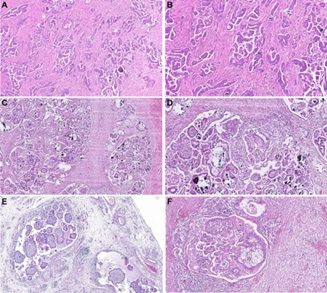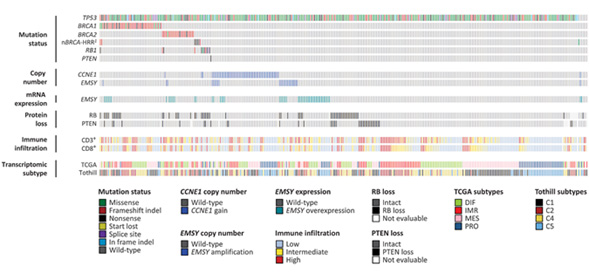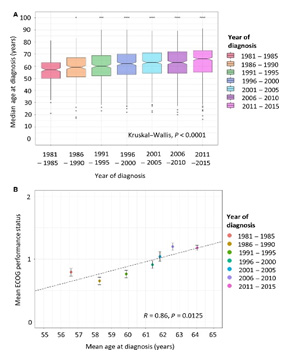Research Papers

Distinct histopathological features are associated with molecular subtypes and outcome in low grade serous ovarian carcinoma.
- Low grade serous ovarian cancer patients with specific genetic changes have some distinctive tumour features that can be seen under the microscope
This paper illustrated patterns in histopathology, as seen by a pathologist, could be linked to specific clinical outcomes, in Low Grade Serous Ovarian Cancer.
Sci Rep 13, 7681 (2023). >> Read Article

Whole exome sequencing of low grade serous ovarian carcinoma identifies genomic events associated with clinical outcome.
- Low grade serous ovarian cancer shows multiple genomic subgroups that have distinct clinical and molecular features. These identify specific patients with poor outcome when treated with currently available therapies. Our data suggest specific biological pathways that may be targetable to improve survival for these patients
Data in this publication indicated patient specific genomic differences, as detected via research, were linked to clinical outcome in Low Grade Serous Ovarian Cancer.
Gynecologic Oncology, Volume 174, 2023, Pages 157-166. >> Read Article

Multiomic Characterization of High-Grade Serous Ovarian Carcinoma Enables High-Resolution Patient Stratification.
- By integrating different types of genomic data we demonstrated the implications of different biology on treatment sensitivity and patient outcome.
This paper illustrated how using different layers of patient specific information, improved patient stratification. Such ‘personalised medicine’ could improve treatment and patient outcome in High Grade Serous Ovarian Cancer.
Clin Cancer Res. 2022 Aug 15;28(16):3546-3556. >> Read Article

Ovarian carcinosarcoma is a distinct form of ovarian cancer with poorer survival compared to tubo-ovarian high-grade serous carcinoma.
- We showed that ovarian carcinosarcoma is an uncommon, complex and highly aggressive ovarian cancer type, which is less responsive to standard chemotherapy compared to the most common ovarian cancer type.
Data from a highly curated Ovarian Carcinosarcoma (OCS) patient cohort, clearly showed how different OCS is from other types of ovarian cancer and so may need different approaches to treatment and patient care.
Br J Cancer. 2022 Oct;127(6):1034-1042. >> Read Article

Integrated molecular characterisation of endometrioid ovarian carcinoma identifies opportunities for stratification.
- Our data demonstrated favourable outcome for certain groups of patients endometrioid ovarian cancer, and may represent a meaningful way to identify patients with high- and low-risk disease
This paper clearly illustrated how diverse cancer can be. Even in tumours of the same type (Endometrioid Ovarian Cancer) many differences are seen between patients and these differences could be utilised to inform future treatment.
NPJ Precis Oncol. 2021 Jun 2;5(1):47 >> Read Article

Clinicopathological Determinants of Recurrence Risk and Survival in Mucinous Ovarian Carcinoma.
- Patients diagnosed with mucinous ovarian cancer (MOC) often experience excellent long-term survival.
- Patients who are disease free 5 years after diagnosis are unlikely to subsequently relapse.
- Post-relapse survival in recurrent MOC is extremely poor and further treatment options are urgently needed to improve clinical outcomes in this context.
Once again, in a different type of ovarian cancer, Mucinous Ovarian Cancer, it is possible to show how different the tumours can be between patients. Hopefully, these differences can be used to improve patient treatment and care.
Cancers (Basel). 2021 Nov 21;13(22):5839. >> Read Article

Structural Variants at the BRCA1/2 Loci are a Common Source of Homologous Repair Deficiency in High-grade Serous Ovarian Carcinoma.
- These results demonstrate that structural variants in BRCA1 and BRCA2 genes are an underappreciated and under-detected mechanism of loss of BRCA1 and BRCA2 in a number of cancers
- These findings suggest a new way to detect patients suffering from ovarian and other cancers that are likely to benefit most from PARP inhibitor therapy
This paper showed how modern genomic analysis can detect previously undetected genetic changes and, most importantly, how these new changes allow patients to be treated using newer, more effective drugs such as PARP-inhibitors.
Clin Cancer Res. 2021 Jun 1;27(11):3201-3214. >> Read Article

Patterns of clinicopathological features and outcome in epithelial ovarian cancer patients: 35 years of prospectively collected data.
- A significant improvement in ovarian carcinoma survival has occurred over the last 35 years. Most of this improvement is due to an extension of survival following disease relapse.
This data illustrates how ovarian carcinoma patient survival has improved over the last 3 decades and importantly this is driven by improved treatment and better survival following relapse.
BJOG. 2020 Oct;127(11):1409-1420. >> Read Article

Molecular stratification of endometrioid ovarian carcinoma predicts clinical outcome.
- We demonstrated that endometrioid ovarian cancer is a molecularly heterogeneous disease, comprising multiple genomic subtypes. These subtypes demonstrate differential clinical outcome and clinicopathological features.
Endometrioid Ovarian Cancer can be significantly different at the genetic level and these genetic differences can influence clinical outcome.
Nat Commun. 2020 Oct 5;11(1):4995. >> Read Article

Hormone receptor expression patterns define clinically meaningful subgroups of endometrioid ovarian carcinoma.
- These data demonstrate that endometrioid ovarian cancer cases with high progesterone receptor expression display markedly favourable outcome.
This paper showed how changes in the amount of a single protein within a tumour can influence disease outcome. Knowing this information may lead to new methods of treatment for these patients.
Gynecol Oncol. 2019 Nov;155(2):318-323. PMID: 31495455 Free PMC article. >> Read Article

